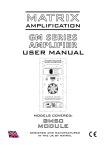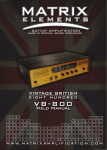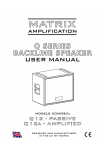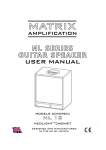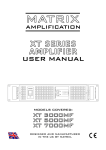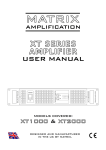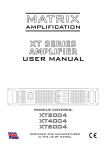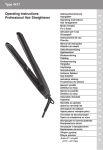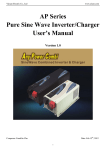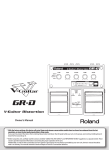Download Matrix GT1500FXBD Specifications
Transcript
CONTENTS: Page Thank You 1 1. Features and Innovations 2 2. Specifications Thank You Congratulations on the purchase of your new Matrix Professional Power Amplifier. Matrix products are the result of a collaboration between Designers, Engineers and Musicians with many decades of experience in the design and practical in field application of exceptionally robust, reliable and ergonomic audio equipment. In addition, amplifier designer - Andrew Hunt & all of us at Matrix would like to extend a special thank you to French guitar amp-guru Bruno Durand. Whose invaluable, skilled input made the design of this unique amplifier possible. 3-4 2.1 Technical specifications 2.2 Basic Schematics 3. Interface Elements 5-7 3.1 Front Panel 3.2 Rear Panel 4. Recommended Usage 5. Cables, Making your own 8 09-10 6. International Voltage Select. 11 7. Trouble Shooting 12 8. Warranty 13 9. Declaration of CE Conformity 14 This manual will help you to get the most from your amplifier. For maximum benefit, it is recommended that all instructions and warnings are carefully read. Where unsure about anything, please consult a qualified technician. For warranty service, please retain your receipt and all packaging that comes with the amplifier, as it has been specifically designed to transport the amplifier safely. Unpacking CAUTION: OBSERVE ALL SAFETY AND USAGE INSTRUCTIONS TO AVOID POSSIBLE DAMAGE TO EQUIPMENT AND EXPOSURE TO HAZARDS (THIS SYMBOL UNIVERSALLY FLAGS CAUTION Please unpack and inspect your new amplifier for any damage that may have occurred during transit. If damage is found, notify the carrier immediately. Note: A suitable mains lead is provided and can be found packaged with the amplifier. PLEASE RETAIN ALL FACTORY PACKAGING FOR ANY FUTURE POSTAL TRANSIT. NOTICES) LETHAL VOLTAGES PRESENT AT SPEAKER TERMINALS AND INSIDE THE AMPLIFIER; ENSURE ALL WIRING IS SAFE AND CORRECT BEFORE USE. (THIS SYMBOL ALSO UNIVERSALLY FLAGS ELECTRICAL HAZARDS) DO NOT OPEN THE AMPLIFIER; LEAVE ALL INTERNAL SERVICE OPPERATIONS TO A QUALIFIED TECHNICIAN. GT SERIES USER MANUAL 3 1. Features and Innovations All our amplifiers have been designed to give the best possible performance for their intended application and are based on our own uncompromising, time proven MOSFET designs. These take advantage of components which will stand the test of time and give the best possible performance in a small, exceptionally light weight package. We only have the desire to provide our users with the best possible solutions and continue to look for ways to improve upon them. Amplifier features: Design Optimised for Guitar Amplification. Class AB, MOSFET amplifier topology. Three independent Mono amplifier channels in one unit of rack space. Designed primarily as a one box solution for wet/dry/wet setups, however there are many other situations where this configuration is likely to prove invaluable. .. An unprecedentedly powerful and stable Switch Mode Power Supply. Designed without compromise, to exceed the performance of the previous linear supply models; whilst offering a weight advantage rarely seen even in other SMPS amplifiers. . Soft Start Circuit. The power supply is designed not to draw excessive current on startup - Prevents the 'thump' as occasionally occurs with other equipment, from tripping fuses and breakers. . Protection against Short Circuit and Overheating. . Speaker Protection relay with delay to inhibit switch on thump. The speakers are disconnected during power up/down. Fully balanced XLR Inputs, which also accept 1/4” jack connectors.. . Speakon / 1/4” Jack Combi Outputs. Expanded output options for guitar amplifier use. . Temperature regulated, High Speed Fan Cooling. A high speed fan is utilised to ensure maximum reliability by allowing for far greater cooling latitude (The amplifier vents hot air through rear connector panel). . 0.775v / 0 dBu Inputs. Input level optimised for guitar amplifier use. . 1U Case Format. Compact amplifier format designed to optimise the use of available racking space. REV.1.22 MATRIX AMPLIFICATION 4 GT SERIES USER MANUAL 2.1 Technical Specifications GT 1500 FXBD Number of Channels: 3 Watts Per Channel at - 16 Ω: 150 Watts Per Channel at - 8 Ω: 300 Watts Per Channel at - 4 Ω: 500 - Supply Voltage: 230V +/- 15% Internally Selectable Alternative Voltage: 110V +/- 15% Average Supply Current, Full Load: 6A (12A at 110v) Mains Connector: 10A IEC Frequency Response: 8–24,000 Hz Signal to Noise Ratio (ref. Full power 1kHz): 96 dB THD (1kHz, full power): 0.06% THD (20Hz - 20kHz, full power): <0.1% Slew Rate: 50 V/µs Damping Factor (ref. 8R, 100Hz): >400 Cooling Fan Arrangement: (Temperature controlled dual speed fans) 2x 40mm Input Level Sensitivity: 0.775v / 0 dBu Dimensions (mm): 482 X 44 X 210 Weight: 3.8 Kg Operating Environment: ● ● ● ● The amplifier is designed for use in environments which protect it from rain, unusually high air humidity and temperature. When mounting inside, ensure that the amplifier is securely bolted into a rack using all available fixing points where possible. Otherwise place on a surface where it cannot be easily displaced, Potentially causing damage/injury. Ensure That the location will not expose the amplifier to spillage of liquids/drinks, sprays/vapours or high humidity. Ensure the amplifier is installed in a place which is not subject to abnormally high temperatures and maintain sufficient ventilation to prevent overheating. For temporary use outside, apply similar caution; however be extra sure to ensure placement accounts for changing weather conditions and that extreme wind/rain/heat will not find its way to equipment. When taking any equipment from a cold environment (unheated storage, vehicles, etc), into a warm one, allow the equipment time to acclimatise to the ambient temperature, as condensation is likely to form in the amplifier, potentially causing it to malfunction if put into service too soon. Note: Our policy of continuous improvement may lead to the above specifications being exceeded prior to documentation being updated. GT SERIES USER MANUAL 5 2.2 Basic Schematics. Output Connections: Output Connector Format Options: REV.1.22 MATRIX AMPLIFICATION 6 GT SERIES USER MANUAL . 3. Interface Elements, Front Panel. . (1) Power Switch This switch controls the power supply to the amplifier. There is a short delay on power-up, this is to avoid switch-on "thump" which could damage the loudspeakers. . (2) Gain Controls The level of each Channel is individually adjusted by these controls. Rotating these controls fully clockwise, results in no attenuation to the incoming audio signals. . (3) Indicator Section, Status: a. Power Indicators This indicator shows when the amplifier is on and each channel is receiving power. b. Protect Indicators These indicators light briefly during the power up cycle and also light should a fault occur. Illumination of the protect indicators, shows that the output of the amplifier has been disconnected by means of an internal relay to protect connected speaker systems from being damaged by the fault. (4) Indicator Section, Signal levels: a. Output Level Display These show the (Peak) output level of the amplifier for each channel. Note: It is useful to remember for trouble shooting, that the sensors for the Output Level Display, detects levels after the output relays. Therefore if the display is operating, a signal is present at the speaker sockets when driven above a threshold of approximately -9db. Also note that when operating signal level is low, the led may not illuminate. In this instance observe signal presence either by increasing volume until led illuminates, or listen to speaker output to verify correct operation. For further information on the signal lights and how they relate to the power the amp is generating please visit http://uk.matrixamplification.com/faq/technical-product-guides.html GT SERIES USER MANUAL 7 3. Interface Elements, Rear Panel. . (5) Cooling Fan Outlet . Hot air exits here. Make sure all rear (and front) ventilation paths are free from obstruction and air flows freely, otherwise the amplifier will trip into thermal protect mode prematurely and in some extreme circumstances damage may occur. (6) Output Connectors . The Output sockets are Neutrik Speakons and accept a Neutrik NL4FC plug. Avoid inferior alternatives, as they may present numerous hazards due to less than ideal construction. Insert the plug and turn clockwise until you hear it click. This ensures correct connection has been made. To remove, pull back the levered tab and turn anti-clockwise. Ready-made, sensibly priced, quality interconnection leads suitable for use with the amplifier should be easy to source. However, with sufficient skill, it is possible to make/modify leads for the task. proceed to Chapter 5. - “Cables, Making your own”. NOTE: Only the first two pins (+1 and -1) are connected to the indicated channel. In addition please ensure that cables purchased or assembled for the purposes of connecting the amplifiers outputs are suitable for this task. If unsure, please consult a qualified technician. Failure to use appropriate wiring could damage the amplifier, associated equipment or present a fire/electrocution risk under certain circumstances. CAUTION: Whilst we recommend that Neutrik speakon connections are always used for the safest way of connecting to the amplifier, the option is also provided to use 1/4” jack connections with these outputs. Take extra care when connecting leads to ensure that these are not accidentally connected to the inputs and outputs of other equipment not designed specifically to do so, otherwise damage to equipment is likely to occur. Take extra care with 1/4” jack speaker connections, the exposed plug end can present an electric shock hazard, also never allow the outputs to be shorted, equipment damage may occur. Finally, note that standard 1/4” interconnect leads are not suitable for connection between amplifier and loudspeaker, choose one designed for this specific task for safe operation and optimal performance. REV.1.22 MATRIX AMPLIFICATION 8 GT SERIES USER MANUAL GT SERIES USER MANUAL 9 (7) Input Signal Sockets . These are combined female XLR and 1/4" jack sockets. They provide a number of connection possibilities, including the industry standard Balanced XLR system, which helps ensure interference and noise free connections between equipment. Ready-made, sensibly priced, quality interconnection leads suitable for use with the amplifier should be easy to source. However, with sufficient skill, it is possible to make/modify leads for the task. Proceed to Chapter 5. - “Cables, Making your own”. (8) Power Connection. . Mains power is supplied to the amplifier by a standard 10 Amp IEC mains socket. An appropriate mains lead is supplied with the amplifier. Note: The amplifier requires a stable power supply to function as intended. Ensure that the power source (mains power supply, generator, etc.) is suitable for this application and adequate power is available. Poorly selected power sources result in sub-optimal performance, increased likelihood of tripping breakers, blowing fuses and in extreme situations damage to equipment may occur. Should the fuse in the mains lead blow for any reason, it must be replaced with a fuse of the correct rating. This should be 13 amps for the models listed in this manual. However, if there is any reason to believe that a malfunction caused the fuse to blow, stop using the equipment immediately and take the amplifier to an authorised service engineer for servicing. Note: This equipment has been tested and found to comply with the limits for a Class B digital device, pursuant to part 15 of the FCC Rules. These limits are designed to provide reasonable protection against harmful interference in a residential installation. This equipment generates, uses and can radiate radio frequency energy and, if not installed and used in accordance with the instructions, may cause harmful interference to radio communications. However, there is no guarantee that interference will not occur in a particular installation. If this equipment does cause harmful interference to radio or television reception, which can be determined by turning the equipment off and on, the user is encouraged to try to correct the interference by one or more of the following measures: — Reorient or relocate the receiving antenna. REV.1.22 MATRIX AMPLIFICATION 10 GT SERIES USER MANUAL — Increase the separation between the equipment and receiver. — Connect the equipment into an outlet on a circuit different from that to which the receiver is connected. — Consult the dealer or an experienced radio/TV technician for help. 4. Recommended Usage: To ensure your speaker and amplifier system functions optimally, it is advised to read through everything covered in this manual. Safety precautions and appropriate usage recommendations for specific connections and features are noted in the previous section. . 4.1 Matching Speakers to the amplifier: . When matching loudspeakers appropriately to the available amplification refer to the recommendations provided by the cabinet/speaker manufacturer. If unsure, please consult a qualified technician. Typically we will note however, that loudspeaker manufacturers will recommend that the the amplifiers output power matches the specified power of the loudspeaker fairly closely. This ensures that the speaker does not receive more power than it is able to handle without potential failure / damage or unintended, distortion of sound occurring. Also ensuring the amplifier is not too small to drive the loudspeaker to its full output level is important in preventing accidental damage through hard clipping resulting from attempting to drive the amplifier outside of its full output capability – this can easily prove fatal for even the largest of loudspeakers and may damage the amplifier too. It remains however the users responsibility to be sure that correct levels are maintained. When connecting multiple loudspeakers to the same audio channel please note that depending on wiring configuration (series, parallel, series-parallel, etc) changes the impedance of the the load the amplifier 'sees'. The amplifier should have no less than 4 ohms nominal connected to each channel. Typical configurations which dont exceed this would be: Two 8 ohm speakers connected in parallel or 8x 8ohm speaker pairs connected in series-parallel configuration. If unsure about appropriate setup configurations, please consult a suitably qualified engineer. 4.2 Important Notice regarding connection to multiple input and switchable input cabinets. Care must be taken when connecting the amp to any cabinet that has more than one jack plug or socket or features switchable stereo/mono operating modes. Certain cabinets are known to have more than one socket but are not stereo capable cabs. Orange 2x12 and 4x12 cabs for instance have two unlabeled parallel inputs. Connecting the amplifier to both inputs effectively shorts the amplifiers outputs and will cause damage to the amplifier. This will not be covered under warranty. Similarly, cabinets which feature stereo/mono switchable inputs must always be switched to stereo operation when both channels of the amplifier are connected to it. Switching to mono mode will turn the input into a parallel output and again effectively link and short the amps channel outputs together. If you are unsure of your cabinets’ specifications, please refer to the manufacturer’s instructions or consult a qualified technician for guidance. GT SERIES USER MANUAL REV.1.22 11 MATRIX AMPLIFICATION 12 GT SERIES USER MANUAL 5. Cables, Making your own. 5.1 Signal Level Leads. Standard Audio Connectors: Cable Maker Table: Cable Connections: Cable Type: Ground/Screen Red/Central Cable White balanced to balanced 1 to 1 2 to 2 3 to 3 balanced to unbalanced 1 to 1 2 to 2 3 tied to 1 unbalanced to unbalanced 1 to 1 2 to 2 - Note: Shell Ground tab on XLR connectors is usually tied to ground at pin 1. Choosing a Cable: For balanced connections, use a good quality metal braid screened cable with two inner wire cores; this will usually be clearly marketed as pro audio/microphone signal cable. For long cable runs in excess of 6m/20ft, try to use cables with lower capacitance ratings, to minimise any loss of sound quality. Keep cable runs short where possible, however be sure allow a little bit of slack in the length of cable used to make the lead. Stretched, overstressed cables tend to break at the most inconvenient moments. GT SERIES USER MANUAL 13 5.2 Speaker Leads. Speakon Connector (4 pin) and 1/4” Jack: Cable Maker Table: Cable Connections: Cable Type: Single Channel, 2 core lead. + and - + and - 1 to 1 - Outputs A, B and C - 4 ohms min. load Bridged (mono) mode. Not Applicable. Choosing a suitable Cable: For most applications we recommend a twin core cable with a copper core of at least 2.5mm 2 / 12 awg & sold for the purpose of connecting power amplifiers to loudspeakers. For cables longer than 6m/20ft a heavier gauge cable may provide improved performance. An approximate guide of cable sizing in relation to that of a pencil is shown below, also note on the right the thin 'bell wire' / budget domestic speaker cable... never use cable of this gauge to connect to power amplifiers, this can present a fire risk and will result in poor performance. REV.1.22 MATRIX AMPLIFICATION 14 GT SERIES USER MANUAL GT SERIES USER MANUAL 15 6. International Voltage Selection Although the GT series amplifiers are labelled as per the voltage of the region they are sold for use within, it is possible with most models to select alternative region voltages internally via an on-board switch. This allows for selection of 230v or 110v modes respectively at +/- 15%. This is approximately 200 to 265v or 95 to 125v. If you are unsure about undertaking this procedure, please refer to qualified service personnel. . To access the internal switch, firstly disconnect amplifier from all equipment & mains supply as lethal voltages are present inside. Next remove the screws on the lid shown below with a suitable cross head screwdriver, the lid should now simply lift away without obstruction, should any resistance be encountered, inspect for further fasteners holding the lid down. Within the region indicated below by the dotted area a internal view similar to that shown below should be visible. With a finger or ballpoint pen move the switch shown into its alternative position for secondary voltage mode. Re-assemble amplifier ensuring all fixings are tight before further use. Note: - Ensure correct voltage for region is always selected, otherwise damage is likely to occur ! REV.1.22 MATRIX AMPLIFICATION 16 GT SERIES USER MANUAL GT SERIES USER MANUAL 17 7. TROUBLE SHOOTING. . (1) ALWAYS: ● Ensure wiring is safe and correct. ● Ensure the amplifier has no less than 4 Ohms worth of loading across each channel. . (2) NORMAL ARTIFACTS: ● ● . When heavily driven, the amplifier itself may make a noticeable hissing sound in relation to the supplied signal. This is a normal phenomenon relating to the behaviour of certain components which vibrate slightly under the high powers involved. The Fans on the GT SERIES may appear to generate more noise than earlier models, they run at higher speeds to increase the cooling efficiency of the amplifiers. They will also increase their speed when the amplifier is under load. (3) THE POWER LIGHTS DO NOT ILLUMINATE 1. 2. 3. 4. (same 5. 6. . Check that the mains supply is turned on. Check that the mains switch is turned on. Check Mains lead for damage and check fuse. Replace lead if damaged, replace fuse if blown. Check internal fuse. Replace if blown. type of fuse specified/installed must be used, do not change) If fuse re-blows refer to service personnel. If fuse has not blown, but the amplifier still malfunctions, refer to service personnel. (4) THE AMPLIFIER IS WORKING, BUT OUTPUT VOLUME IS LOW . ● . Check the signal from the input source and signal cables. The amplifiers are designed to operate at an input voltage of 0.775V. If the intended signal source is above this, refer to qualified service personnel for a minor modification. (5) AMP OUTPUT LEVEL INDICATORS ARE WORKING, BUT NO SOUND IS COMING OUT . ● Check Output connectors are securely attached. (The amplifier will be operating if the output level indicators are working) . (6) THE AMPLIFIER IS GIVING A LOWER OUTPUT THAN NORMAL, WITH DISTORTION . ● . The protection circuits (current clamps) are operating. Check all leads for short-circuits. Try another set of leads and loudspeakers. (7) THE AMPLIFIER IS OVERHEATING . ● ● ● Check that the fan is not obstructed with debris, and is rotating freely. Check speaker leads for short circuits. Check to see that amplifier output 'negatives' have -not- been connected together in bundled cable looms. If any of these, or other symptoms persist, Please contact us with the details below for help, advice and service: Contact Details: Email: [email protected] REV.1.22 Address: MATRIX AMPLIFICATION LIMITED, Unit 1b, Techways, Wonastow Road Industrial Estate, Monmouth, Wales, NP25 5JA. MATRIX AMPLIFICATION 18 GT SERIES USER MANUAL If the amplifier is to be shipped, use factory packaging or other secure method as transit damage is not covered by the warranty. Full Two Year Warranty Summary of Warranty . Matrix Amplification Limited, warrant to you, the ORIGINAL PURCHASER of each Matrix Power Amplifier, for a period of 2 (two) years from the date of purchase, that the amplifier is free from defects in materials and workmanship and we further warrant the new Matrix Amplifier, regardless of the reason of failure except as excluded in this warranty. Items Subject to Exclusion from this Warranty . This Matrix Amplifier Warranty is in effect only for failure of a new Matrix Amplifier which occurred during the warranty period. It does not cover any product that has been damaged because of any misuse be it intentional or otherwise, accident, negligence, or loss which is covered under any insurance. What the Warranter Will Do . We will remedy any defect, regardless of the reason for failure (except as excluded above), by repair or replacement. Warranty work can only be performed at our authorised distributors or at Matrix Amplification Limited. We will remedy the defect and ship the product from the service centre or our own factory within a reasonable time after receipt of the defective product. All expenses in remedying the defect, including freight costs from ourselves to you (within mainland UK) will be borne by us. You must bear the costs of shipping the product to our authorised service centre or factory. How to Obtain Warranty Service . You must notify us of your need for warranty service not later than the expiry of your warranty. The amplifier must be shipped in a factory pack, which if required can be obtained from us at a modest charge. The amplifier must be sent to us carriage paid and insured. Corrective action will be taken within a reasonable time from the date of receipt of the defective product by us or our authorised service centre. If repairs made by us or our authorised service centre are not satisfactory, contact us immediately. Warranty Alterations .. No person has the authority to enlarge, amend or modify this warranty. The warranty is not extended by the length of time which you are deprived of the use of the amplifier. Repairs and replacement parts will only carry the unexpired portion of this warranty. Design Changes . Matrix Amplification Limited has a policy of continuous improvement to designs without notice and with no obligation to make corresponding changes in products previously manufactured. Your Statutory Rights are Unaffected by this Warranty GT SERIES USER MANUAL 19 Declaration of CE Conformity Issuers Name and Address: Andrew Hunt, MATRIX AMPLIFICATION LIMITED, Unit 1b, Techways, Wonastow Road Industrial Estate, Monmouth, Wales, NP25 5JA. Products: GT1500FXBD Equipment Type: Commercial Audio Power Amplifiers. Safety Standard: AMD1: 2005 and IEC 60065: 2001 7th Ed. Safety Requirements - Audio Video and Similar Electronic Apparatus. EMC Standards: EN 61000-4-2:2001 Electrostatic Discharge Immunity (Environment E2-Criteria B, 4k V Contact, 8k V Air Discharge). EN 61000-4-3:2006 Radiated, Radio-Frequency, Electromagnetic Immunity (Environment E2, criteria A). EN 61000-4-4:2007 Electrical Fast Transient/Burst Immunity (Criteria B). EN 61000-4-5:2006 Surge Immunity (Criteria B). EN 61000-4-6:2006 Immunity to Conducted Disturbances Induced by Radio-Frequency Fields (Criteria A). EN 61000-4-11:2001 Voltage Dips, Short Interruptions and Voltage Variation. EN 55103-1:1997 Electromagnetic Compatibility - Product Family Standard for Audio, Video, Audio-Visual and Entertainment Lighting Control Apparatus for Professional Use, Part 1: Emissions. EN 55103-1:1997 Magnetic Field Emissions-Annex A @ 10 cm and 20 cm. EN 55103-2:1997 Electromagnetic Compatibility - Product Family Standard for Audio, Video, Audio-Visual and Entertainment Lighting Control Apparatus for Professional Use, Part 2: Immunity. EN 61000-3-2:2005 and AMD1: 2008 Limits for Harmonic Current Emissions (equipment input current less than or equal to 16 A per phase). EN 55022:2006 Limits and Methods of Measurement of Radio Disturbance Characteristics of ITE: Radiated, Class B Limits; Conducted, Class A. EN 61000-3-3:2008 Limitation of Voltage Fluctuations and Flicker in Low-Voltage Supply Systems Rated Current less than or equal to 16A. Declaration: I certify that the product identified above conforms to the requirements of the EMC Council Directive 89/336/EEC as amended by 92/31/EEC, and the Low Voltage Directive 73/23/EES as amended by 93/68/EEC. REV.1.22 MATRIX AMPLIFICATION 20 Signatories: Andrew Hunt, Managing Director. GT SERIES USER MANUAL Date of Issue: 15 October 2012.




















